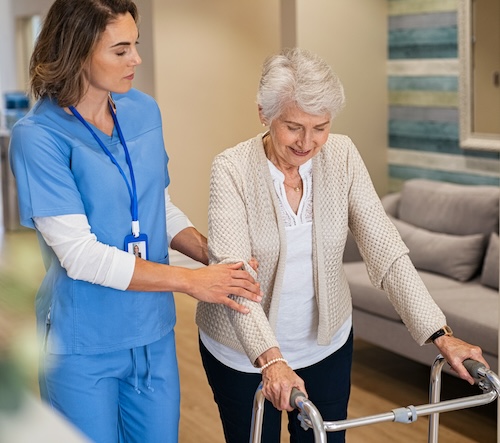Falling is one of the most significant risks to seniors’ health and independence. They are the leading cause of fatal and non-fatal injuries among older adults, according to the National Council on Aging. Injuries suffered during a fall can have devastating effects that impact quality of life, including chronic pain and the loss of independence.
The good news is, with precautions and support, many falls can be prevented. Read on to learn some practical tips and strategies to help seniors stay safe in their homes or in assisted living facilities.
1. Conduct a Safety Assessment
If your senior loved one is living at home, begin by assessing their environment for potential hazards. Look for loose rugs, cluttered pathways, uneven flooring, slippery surfaces, and poor lighting. Addressing these issues significantly reduces the risk of falls. If you use senior in home care services, they can help implement safety measures.
2. De-Clutter
A senior’s home—or room in an assisted living facility—is the perfect place to apply Marie Kondo’s KonMari methods. Keeping a neat house is an ideal and inexpensive way to prevent falls. Help your senior loved one de-clutter and remove items that cause falls, like piles of books and periodicals that they often surround themselves with. Pack away unnecessary items and remove anything that doesn’t spark joy—or may create an obstacle on the floor and in hallways.
3. Install Grab Bars and Handrails
Mobility grows more limited as we age. Simple things like using the restroom or kitchen may become more difficult for seniors. Install grab bars and handrails in these key areas, as well as stairways and hallways. This provides essential support and stability, especially in areas where slips and falls are more likely to occur.
4. Non-Slip Accessories
Bathrooms and kitchens are two of the most hazardous areas as they become extremely dangerous when wet. Prevent falls on slick surfaces with non-slip accessories like mats, socks and grip tape.
5. Proper Footwear
Supportive footwear with non-slip soles for both indoors and outdoors are game-changers for seniors. Discourage the use of high heels, loose slippers, or worn-out shoes, as they compromise stability and increase the likelihood of slips and falls.
6. Boost Lighting
Ensure that all areas of a senior’s home or room are well-lit, including entrances, hallways, and staircases. Motion-sensor lights and nightlights can illuminate pathways at night and provide extra safety measures.
7. Promote Regular Exercise
Regular exercise programs focused on improving strength, balance, and flexibility are ideal for seniors. Activities like yoga, tai chi, or gentle stretching exercises improve stability and reduce the risk of falls, while enhancing overall health and well-being.
8. Review Medications Regularly
Periodically audit seniors’ medication regimens with healthcare providers to minimize side effects that increase the risk of falls, such as dizziness, drowsiness, or impaired balance.
Preventing falls among seniors requires a multi-faceted approach that addresses both environmental and individual factors. These tips and strategies will help create a safer environment for seniors to age gracefully and thrive in.

